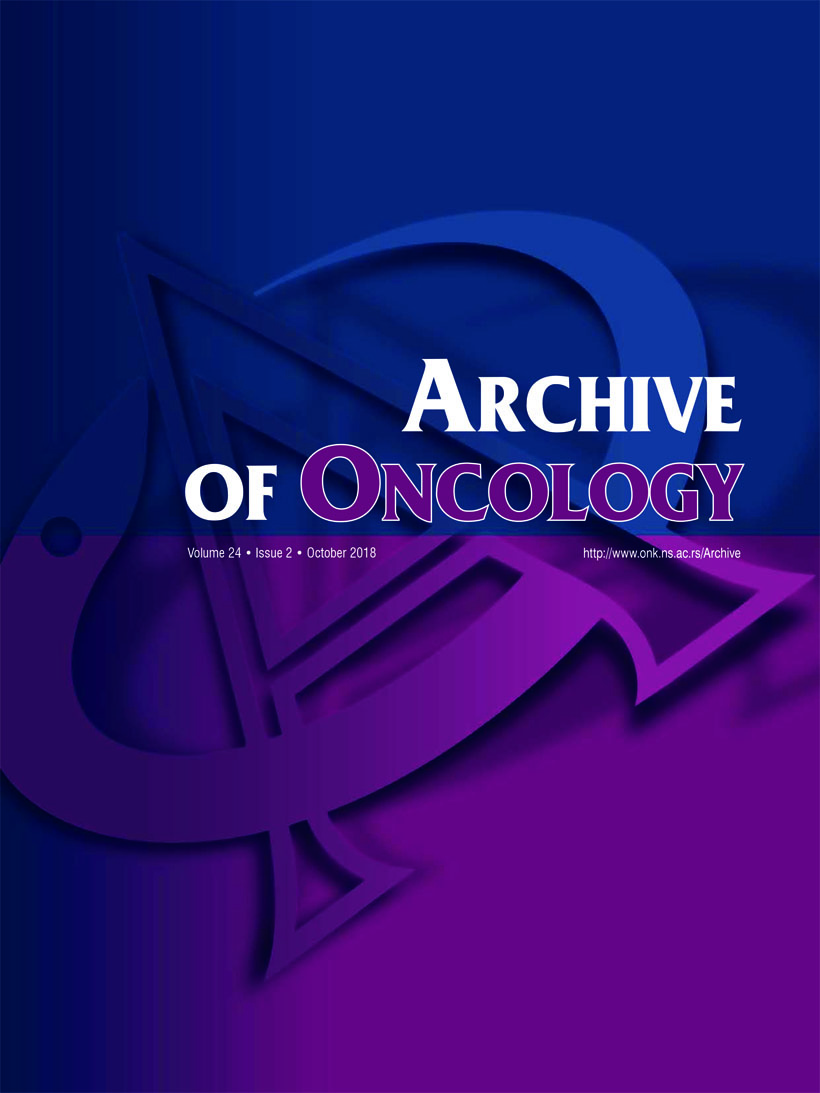Expression of epidermal growth factor receptor in advance stage nonkeratinizing nasopharyngeal carcinoma in West Sumatra, Indonesia
Abstract
Introduction: Nasopharyngeal carcinoma is a head and neck cancer with a unique geographic distribution. Indonesia is one of the countries with an intermediate incidence of nasopharyngeal carcinoma where 13,000 new cases are found every year or 6.2 cases/100,000 in population per year. The subcellular mechanism of the nasopharyngeal carcinoma has not been clearly confirmed, but in several studies overexpression of the epidermal growth factor receptor was found. Based on histopathological classification, nonkeratinizing subtypes consisting of differentiated (WHO II) and undifferentiated (WHO III) are the most frequent types in endemic areas, whereas in non-endemic areas the majority of cases are keratinizing subtype (WHO I). The objective of this study was to evaluate the expression of epidermal growth factor receptor in advanced stage nonkeratinizing nasopharyngeal carcinoma as well as to evaluate difference in the expression between differentiated nonkeratinizing (WHO II) and undifferentiated (WHO III) nasopharyngeal carcinoma that may affect the anti-epidermal growth factor receptor therapy for nasopharyngeal carcinoma. Methods: Biopsies from 34 advance stage (stage III and stage IV) nonkeratinizing nasopharyngeal carcinoma consisting of 17 differentiated nonkeratinizing and 17 undifferentiated carcinomas were included in the study. Expression of epidermal growth factor receptor in tumor tissues was investigated by immunohistochemistry (IHC). Results: Our results demonstrated that epidermal growth factor receptor was expressed in 23 out of 34 subjects (67.65%). Expression in differentiated nonkeratinizing nasopharyngeal carcinoma was 76.47% (13 out of 17), and it was higher than in undifferentiated carcinoma (58.82%), but there was no statistically significant difference between the two histopathological subtypes (p=0.465). Conclusions: The epidermal growth factor receptor was expressed in most cases of advance stage nonkeratinizing nasopharyngeal carcinoma, and there was no difference in the expression between differentiated nonkeratinizing (WHO II) and undifferentiated nonkeratinizing nasopharyngeal carcinoma (WHO III).
References
Ma J, Cao S. The Epidemiology of Nasopharyngeal Carcinoma. In. Lu J.J, Cooper J.S, Lee A.W.M., editors. Nasopharyngeal Carcinoma. Berlin Heidelberg; 2010.p.1-7
Chang ET, Adami HO. The Enigmatic Epidemiology of Nasopharyngeal Carcinoma. Cancer Epidemiologic Biomarkers Prev 2006;15(10):1765-77
Turkoz FP, Celenkoglu G, Dogu GG, Kalender ME, Coskun U, Alkis N et al. Risk Factors of Nasopharyngeal Carcinoma in Turkey- an Epidemiological Survey of the Anatolian Society of Medical Oncology. Asian Pacific J Cancer Prevention 2011;12:3017-21
Ekburaranawat W, Ekspanyaskul C, Brennan P, Kanka C, Tepsuwan K, Temisyatith S et al. Evaluation of Non-Viral Risk Factors for Nasopharyngeal Carcinoma in Thailand: results from a Case-control Study. Asian Pacific J Cancer Prev 2010;11:929-32
Huang YZ, Zhang BB, Ma N, Murata M, Tang A, Huang GW. Nitrative and Oxidative DNA Damage as Potential Survival Biomarkers for Nasopharyngeal Carcinoma. Med Oncology 2011;28:377-84
Thompson LDR. Malignant Neoplasma of the nasal cavity, paranasal sinuses and nasopharynx. In: Head and Neck Pathology, Thompson LDR editors. Elsevier Philadelphia 2006.p.170-3
Roezin A. Faktor Risiko pada Karsinoma Nasofaring. Maj patologi Indonesia 2002; 11(4):42-45
Chan J.K.C., Bray F, Mc Carron P, Foo W. Nasopharyngeal carcinoma in Barnes L, Eveson JW, Reichart P, Sidrasky D editors. WHO classification of tumors: Pathology and genetics head and neck tumors Lyon 2005.p.85-97
Guo X, Johnson RC, Deng H, Liao J, Guan L, Nelson GW, Tang M et al. Evaluation of Nonviral Risk Factors for Nasopharyngeal Carcinoma in a High-Risk Population of Southern China. Int.J.Cancer 2009;124:2942-7
Wei, William I, Nasopharyngeal Cancer. In Bailey, Byron, Johnson, Jonas T, Newlands, Shawn D, editors. Head and Neck Surgery Otolaryngology Fourt Edition. Lippincot Williams and Wilkins; 2006.p.1658-68
Tulalamba W, Janvilisri T. Nasopharyngeal Carcinoma Signaling Pathway: An Update on Molecular Biomarkers. International Journal of Cell Biology 2012.1-10
Brennan B. Nasopharyngeal carcinoma. Orphanet Journal of Rare Diseases 2006;1(1):23
Zeng MS, Zeng YX. Pathogenesis and Etiology of Nasopharyngeal Carcinoma. In. Lu J.J, Cooper J.S, Lee A.W.M., editors. Nasopharyngeal Carcinoma. Berlin Heidelberg; 2010.p.9-20
Lutzky VP, Moss DJ, Chin D, Coman WB, Parsons PG, Boyle GM. Biomarkers for Cancers of the Head and Neck. Clin Med ENT 2008; 1:5-15
Scaltriti M, Baselga J. The Epidermal Growth Factor Receptor Pathway: A Model for Targeted Therapy. Clin Cancer Res 2006;12:5268-72.
Yarden Y, Sliwkowski MX. Untangling the ErbB signaling network. Nat Rev Mol Cell Biol 2001;2:127-37.
Sartor CI. Biological modifiers as potential radiosensitizers: targeting the epidermal growth factor receptor family. Semin Oncol 2000;27(suppl 11):15-20.
Newby JC, Johnston SR, Smith IE dkk. Expression of epidermal growth factor receptor and c-erbB2 during the development of tamoxifen resistance in human breast cancer. Clin Cancer Res 1997;3:1643-1651.
Chen X, Yeung TK, Wang Z. Enhanced drug resistance in cells coexpressing ErbB2 with EGF receptor or ErbB3. Biochem Biophys Res Commun 2000;277:757-763.
Fujii M, Yamashita T, Ishiguro R, Tashiro M, Kameyama K. Significance of Epidermal Growth Factor Receptor and Tumor Associated Tissue Eosinophilia in the Prognosis of Patients With Nasopharyngeal Carcinoma. Auris Nasus Larynx 2002;29:175-81
Huang TL, Li CF, Huang HY, Fang FM. Correlations between Expression of Epidermal Growth Factor Receptor (EGFR), Phosphorylated EGFR, Cyclooxygenase-2 and Clinicopathological Variables and Treatment Outcomes in Nasopharyngeal Carcinomas. Chang Gung Med J 2010;33:619-26
Putti TC, To KF, Hsu HC, Chan AT, Lai GM, Tse G et al. Expression of epidermal growth factor receptor in head and neck cancers correlates with clinical progression: a multicentre immunohistochemical study in the Asia-Pacific region. Histopathology 2002 Aug;41(2):144-51.
Chua DT, Nicholls JM, Sham JS, Au GK. Prognostic Value of Epidermal Growth Factor Receptor Expression in Patients With Advanced Stage Nasopharyngeal Carcinoma Treated with Induction Chemotherapy and Radiotherapy. Int J Radiat Oncol Biol Phys 2004;59:11-20

